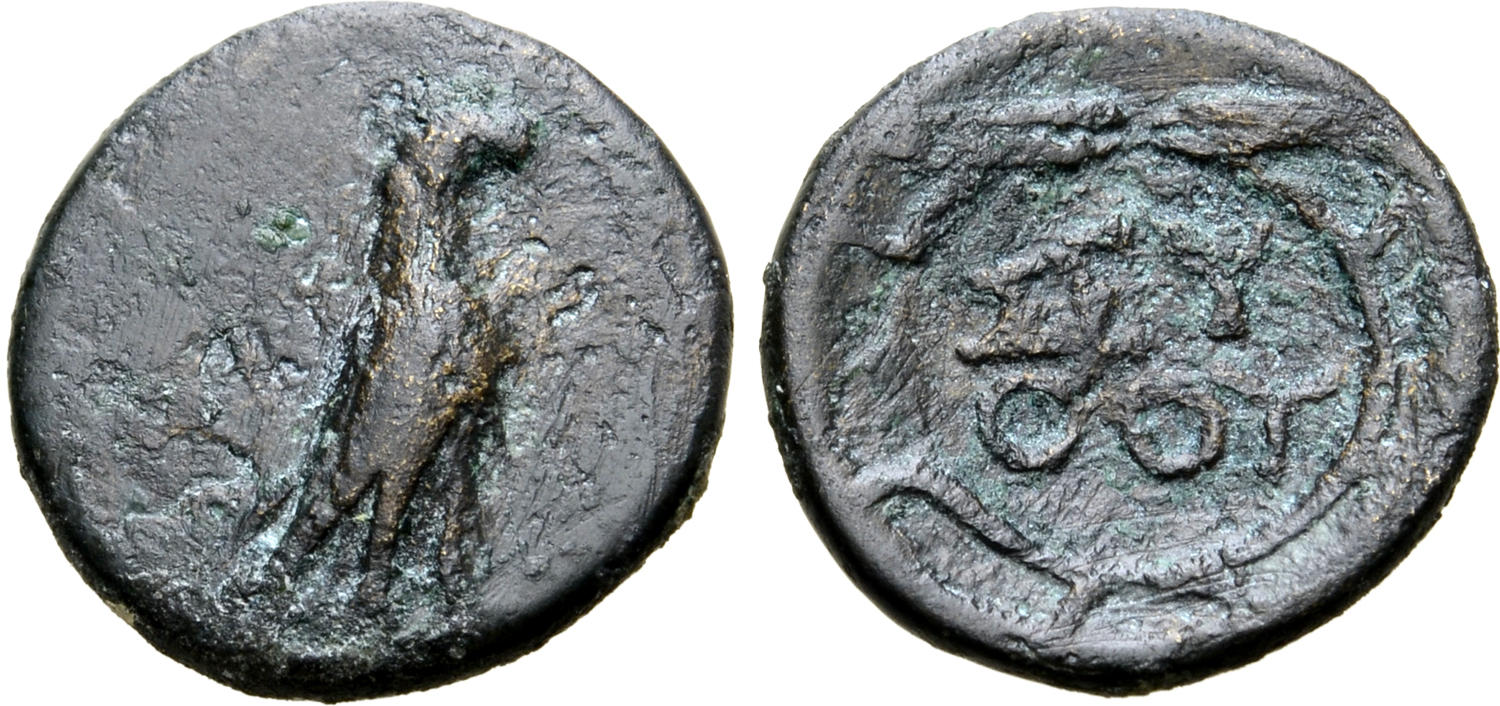Seuthopolis (Seuthes III), bronze (eagle/wreath) (320-309/8 BCE)
From SILVER
320 BCE - 308 BCE Bronze
Description
| ObverseInscription or printing placed on the obverse.: | Eagle with closed wings standing right |
| ReverseInscription or printing placed on the reverse.: | ΣΕΥΘΟΥ (Greek).Wreath of grain ears |
Mint and issuing power
| MintIdentifies the place of manufacture or issue of a numismatic object.: | Seuthopolis | Ancient regionAncient region.: | Thrace | Modern countryModern country: Bulgaria | AuthorityIdentifies the issuing power. The authority can be "pretended" when the name or the portrait of X is on the coin but he/she was not the issuing power. It can also be "uncertain" when there is no mention of X on the coin but he/she was the issuing power according to the historical sources: | Seuthes III (king of the Odrysian kingdom, c. 331-300 BC) |
Chronology
| FromIdentifies the initial date in a range assigned in a numismatic context. | 320 BCE | toIdentifies the final date in a range assigned in a numismatic context.. | 308 BCE | PeriodTime period of the numismatic object.: Hellenistic 323-30 BC |
Physical description
| MetalThe physical material (usually metal) from which an object is made.: | Bronze |
Median weightMedian of the weights of numismatic objects (in grams). in grams | 2.70 | DenominationTerm indicating the value of a numismatic object. Examples: tetradrachm, chalkous, denarius.: | StandardStandard.: |
Image

H85 Seuthès.jpeg [1]
References
| Die study referencePublication of the study: | Dimitrov - Pentchev 19841Dimitrov - Pentchev 1984, n° 469-575 | ||
| Coin series referenceReference to coin series study: | RQEMH2RQEMH, n° 85, HGC 3.23HGC 3.2, n° 1716 | ||
Obverse dies distribution
| FrequencyFrequency of specimen in distribution. ᵖ | Number of obversesNumber of obverse dies. ᵖ (o) | % (o) | Number of coinsNumber of coins. (n) | % (n) | Die nameName(s) of the die(s). |
| 1 | 19 | 55.88 | 19 | 21.84 | 5, 7, 9, 10, 12, 13, 15, 16, 18, 20, 22, 26, 27, 29, 30, 31, 32, 33, 34 |
| 2 | 4 | 11.76 | 8 | 9.2 | 2, 6, 21, 23 |
| 3 | 1 | 2.94 | 3 | 3.45 | 28 |
| 4 | 3 | 8.82 | 12 | 13.79 | 4, 11, 17 |
| 5 | 2 | 5.88 | 10 | 11.49 | 1, 3 |
| 6 | 3 | 8.82 | 18 | 20.69 | 8, 19, 25 |
| 7 | 1 | 2.94 | 7 | 8.05 | 14 |
| 10 | 1 | 2.94 | 10 | 11.49 | 24 |
| Total | 34 of 34 | 99.98 | 87 of 87 | 100 |
Reverse dies distribution
no distribution is available
Quantification
| Number of obversesNumber of obverse dies. ᵖ (o) | 34 | Number of singletons (o1)The number of singleton coins. ᵖ | 19 |
| Number of reverse diesNumber of reverse dies. (r) | 39 | Number of coinsNumber of coins. (n) | 87 |
| Coins per obverse dieNumber of coins per obverse die. (n/o) | 2.56 | Coins per reverse dieNumber of coins per reverse die. (n/r) | 2.23 |
| Reverse per obverse ratioRatio of obverse dies divided by reverse dies. (r/o) | 1.15 | Percentage of singletons (o1)number of coins (n) divided by the number of singletons (o1) ᵖ | 55.88 % |
| Original number of dies (O) (Carter 1983 formula)The estimation of the number of coins according to Carter 1983 ᵖ | 46.77 | Coins struck if 20,000 as average productivity per dieCoins made if the average productivity for obverses (according to Carter) is 20,000. ᵖ | 935,400 |
| Original number of dies (O) (Esty 2011 formula)The estimation of the number of coins according to the singleton formula in Esty 2011 ᵖ (O) | 55.81 | Survival rate if 20,000 as average productivity per dieSurvival rate if average productivity is 20,000. ᵖ | 0.00009 |
| Coverage (o = % of O) (Esty 1984 formula)Esty 1984 - coverage (% of O) ᵖ (o = % of O) | 78.16% | Die productivity if survival rate 1/2,000Average productivity if survival rate is 1/2,000. ᵖ | 3,720.33 |
| Weight of silver (in kg) if 20,000 coins per die (O = Carter formula)Carter 1983 * Median weight * 20000 (*10 if gold or electrum) ᵖ | n.a. | Die productivity if survival rate 1/5,000Average productivity if survival rate is 1/5,000. ᵖ | 9,300.83 |
Remarks
Most likely one single workstation
References
- ^ Dimitrov, Kamen - Pentchev, Vladimir (2004), Seuthopolis, II, Sofia, 161 p., 12 pl.
- ^ Callataÿ, François de (1997), Recueil quantitatif des émissions monétaires hellénistiques, Numismatique Romaine, Wetteren, X + 341 p.
- ^ Hoover, Oliver D. (2017), Handbook of Coins of Macedon and Its Neighbors. 3. Part 2: Thrace, Skythia, and Taurike, Sixth to First Centuries BC, Lancaster-London, xix, 232 p.